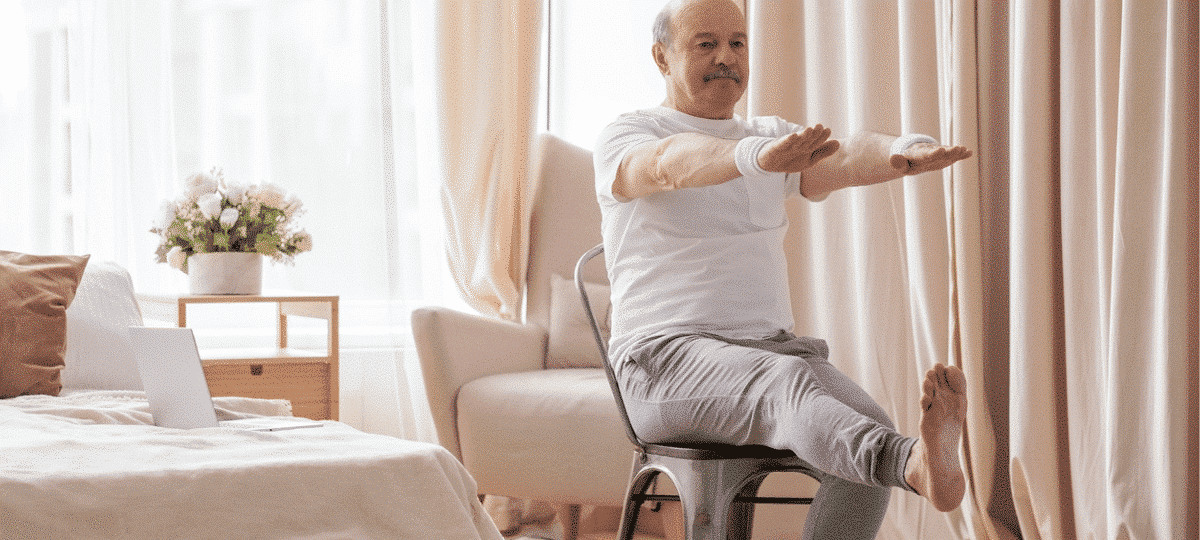With gyms around the country closed due to COVID-19, people need exercise plans that they can do from home or in their neighborhoods. For seniors, a low-impact at-home fitness plan is essential to avoid the risk of injury or fall. Integrating low-impact moves in the routine helps senior citizens protect their bad ankles, hips, knees, and tired bodies. And even though low-impact exercises are not as stressful to the body as high-impact moves, they still get the heart pumping faster and work the muscles thoroughly. Here are six user-friendly and highly beneficial exercises that seniors can do at home.
6 Easy At-Home Exercises for Seniors
Wall Push-ups
Push-ups are excellent exercises for those who want to strengthen their upper body. However, considering that it might be impossible for seniors to get down on the floor due to their health condition, wall push-ups are the best alternative.
- Find a sturdy wall that is more than two feet high.
- Stand as close as possible, and place your hands on the wall straight from your shoulders.
- Maintain an upright posture and bend your elbows to lean towards the wall
- When your face is close to the wall, straighten your arms and push your body away. Repeat this several times.
Low-Impact Jumping Jack
Another simple, yet effective exercise is the low-impact jumping jack. Anybody, including seniors, can do this, but you can add some arm movements for more refined results.
- Stand with your arms down your sides.
- Pull your right foot out, and simultaneously raise your hands above your head. Ensure that your body weight rests on the foot that is on the ground.
- Assume the original position and pull your left foot out while raising your hands above the head.
Bridge with Chest Press
This workout routine is ideal for those who want to work on the hamstring, chest, and core at the same time.
- Lie on your back with knees bent such that your heels are a few inches from your but and your feet about a hip distant apart. Hold a light set of dumbbells on your hands.
- Try to raise your hips as you squeeze your glutes, assuming a single diagonal line from your shoulders to the knees.
- Still, on the bridge position, spread your arms out to the sides and bend the elbows up to 90 degrees, such that your hands extend toward the ceiling. Slowly push the dumbbells over your chest until they come into contact. Then, slowly lower them back and repeat the routine a few times.
Single Foot Stand
Since the loss of balance is one of the leading causes of falls for seniors, a single foot stand is one exercise that can help improve body balance.
- Look for an immobile, steady chair and hold onto to its back.
- Raise your left foot and try to balance your weight on the right foot. Release the chair carefully and try to stand on the right foot for a minute.
- Place your left foot down and then repeat the drill with your right foot raised.
Standing Oblique Crunch
Working the core is an essential aspect if you want to maintain coordinated movement and dexterity. Standing oblique crunch is the best technique to help seniors strengthen their core.
- Stand with your arms holding the back of your head. Then spread your feet shoulder-width apart.
- To get started, bend your right side of the body as you bring your elbow down to meet the raised right-foot knee.
- Assume the original standing position and do the same with the left knee and elbow.
Chair Squats
This is another exciting workout regime for seniors who want to strengthen the lower body. The best thing about the workout is that it is not dangerous since you rest on a comfortable chair if you fall or get tired along the way.
- Stand in front of a lowly placed and comfortable chair with your feet hip-width apart.
- Bend the knees as you maintain your chest and shoulders upright.
- Lower yourself down until you sit down.
- Then raise your body back up and assume a standing position. Repeat the processes for about one minute.
Stay Safe while Exercising
Before beginning any kind of at-home exercise regime, you should make sure to create a safe workout space. Avoid any slick surfaces or spaces with tripping hazards, such as area rugs. Also, make sure you have enough room to move and that you don’t risk bumping into any nearby furniture.
As an added safety measure, wearing a Medical Alert device during your workout ensures that, if anything were to go wrong, you would get the help you need. With a Fall Detection Pendant, an operator could be contacted after a fall without you needing to push your button.
Remember, health and fitness are important, but safety must always come first.



